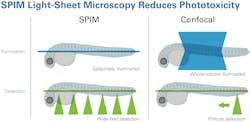Bruker acquires emerging light-sheet microscopy company Luxendo
Bruker (Billerica, MA) has acquired Luxendo (Heidelberg, Germany), a privately held spin-off of the European Molecular Biology Laboratory (EMBL; also in Heidelberg) that develops and manufactures light-sheet fluorescence microscopy instruments. Financial details of the transaction were not disclosed.
Luxendo's patented single-plane illumination microscopy (SPIM) technique reduces sampling times over conventional laser scanning confocal microscopes, which reduces phototoxicity and damaging side effects on living specimens. The SPIM technology also enables fast scan speeds for volumetric imaging of small organisms, cell monolayers, and cleared tissue. Luxendo was founded in September 2015 under the technical leadership of Lars Hufnagel, group leader of the EMBL Cell Biology and Biophysics Unit.
Luxendo launched the MuVi-SPIM and InVi-SPIM microscopes in 2016. The MuVi-SPIM microscope allows fast 3D imaging of living objects, such as spheroids and whole specimens, without the need of sample rotation. The InVi-SPIM microscope enables fast 3D imaging with gentle sample handling for cell cultures and developing embryonic samples.
The SPIM microscopes are an addition to Bruker's own portfolio of swept-field confocal, superresolution, and multiphoton fluorescence microscope products, all used for applications such as small-organism embryology, live-cell imaging, brain development and cleared brain tissue, and optogenetics applications.
"It has been very rewarding to witness the rapid trajectory from pioneering technology developed at EMBL to Luxendo's well-designed, robust microscopes, and now this acquisition," says EMBL Director General Iain Mattaj.
For more information, see www.bruker.com.
Source: Bruker
